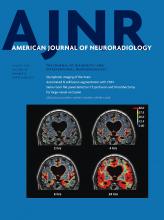Abstract
BACKGROUND AND PURPOSE: The clinical implications of gadolinium deposition in the CNS are not fully understood, and it is still not known whether gadolinium tends to be retained more in the brain compared with the spinal cord. In this study, we assessed the effects of linear gadolinium-based contrast agents on the T1 signal intensity of 3 cerebral areas (dentate nucleus, globus pallidus, and the less studied substantia nigra) and the cervical spinal cord in a population of patients with MS.
MATERIALS AND METHODS: A single-center population of 100 patients with MS was analyzed. Patients underwent 2–16 contrast-enhanced MRIs. Fifty patients received ≤5 linear gadolinium injections, and 50 patients had ≥6 injections: Fifty-two patients had both Gd-DTPA and gadobenate dimeglumine injections, and 48 patients received only gadobenate dimeglumine. A quantitative analysis of signal intensity changes was independently performed by 2 readers on the first and last MR imaging scan. The globus pallidus-to-thalamus, substantia nigra-to-midbrain, dentate nucleus-to-middle cerebellar peduncle, and the cervical spinal cord-to-pons signal intensity ratios were calculated.
RESULTS: An increase of globus pallidus-to-thalamus (mean, +0.0251 ± 0.0432; P < .001), dentate nucleus-to-middle cerebellar peduncle (mean, +0.0266 ± 0.0841; P = .002), and substantia nigra-to-midbrain (mean, +0.0262 ± 0.0673; P < .001) signal intensity ratios after multiple administrations of linear gadolinium-based contrast agents was observed. These changes were significantly higher in patients who received ≥6 injections (P < .001) and positively correlated with the number of injections and the accumulated dose of contrast. No significant changes were detected in the spinal cord (mean, +0.0008 ± 0.0089; P = .400).
CONCLUSIONS: Patients with MS receiving ≥6 linear gadolinium-based contrast agent injections showed a significant increase in the signal intensity of the globus pallidus, dentate nucleus, and substantia nigra; no detectable changes were observed in the cervical spinal cord.
ABBREVIATIONS:
- CP
- middle cerebellar peduncle
- CS
- cervical spinal cord
- DN
- dentate nucleus
- EDSS
- Expanded Disability Status Scale
- GBCA
- gadolinium-based contrast agent
- Gd-BOPTA
- gadobenate dimeglumine
- GP
- globus pallidus
- L-GBCA
- linear gadolinium-based contrast agent
- SI
- signal intensity
- SN
- substantia nigra
- © 2019 by American Journal of Neuroradiology







